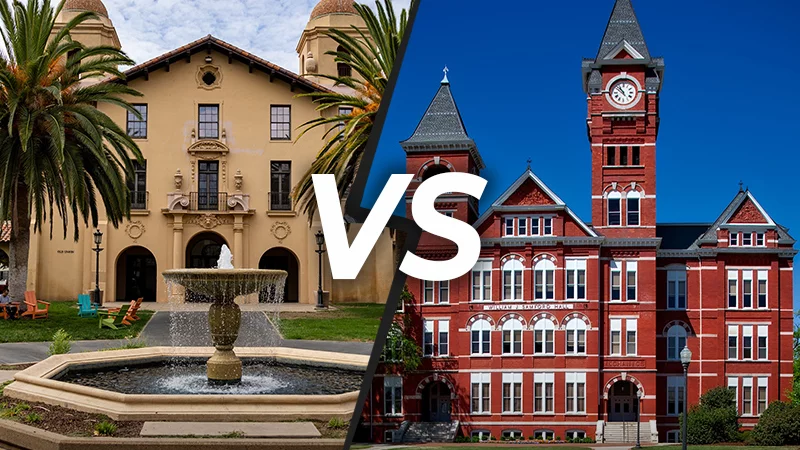
Are Harvard and Stanford on your mind? It’s true, these are two of the world’s most renowned business schools. But if you’ve ever thought they’re pretty similar, think again.
Each of these schools offers a unique student experience shaped by its cultural style and traditions. Unimy’s MBA Cultural Fit has been able to study and compare these differences and now you can discover them for yourself. Harvard vs. Stanford – find out which is your best MBA cultural fit, starting with the first dimension of comparison.
Flexible vs. structured organization
By its own description, Stanford sees itself as a very flexible environment: “At Stanford, students enjoy an unusual degree of academic freedom. The Stanford curriculum is designed with the flexibility to provide students the opportunity to explore courses across disciplines.”
However, flexibility and structure need to co-exist in many different parts of an institution, not just the academic curriculum. Each organization must have its formal and informal rules to be able to work smoothly. At the same time, it needs to be ready to adapt quickly to be able to thrive in times of unexpected change. So, what does that mean for Stanford’s description? Does it fit Unimy’s cultural findings?
Our MBA Cultural Fit not only confirms that Stanford Graduate School of Business is a highly flexible institution, but it even places Stanford as the #1 flexible-oriented business school globally within the MBA cultural fit feature.
If you are the type of student who can think on your feet, if you are used to being more spontaneous rather than following rigid rules – then, the Stanford MBA might be a better cultural fit for you than Harvard.
Compared to Stanford, Harvard Business School falls roughly in the middle on this score globally which means it places more importance on following formal processes and established procedures.

Informal vs. formal relationships at Harvard and Stanford
As an MBA student, would you like to be able to give constructive, yet honest feedback to your business school professors? In institutions that place more value on informal relationships, this will be considered perfectly normal and expected. Even more importantly, professors themselves might be the ones to encourage open feedback and conversation with students in the first place.
This is the case with both Stanford and Harvard when it comes to the power distance between different members of the organization. If you are a student in either of these schools, you can strike up a friendly, informal conversation with your professor despite your different positions within the school. On Unimy’s MBA cultural fit index, Stanford measures as the #3 most informal business school in the world which is consistent with the style of West Coast institutions.
Generally, US schools are more informal than European and Asian ones.
Ad hoc vs. long-term orientation
Imagine you have been successfully accepted into a business school. You immediately start planning your next steps and your upcoming class schedule. You might even start applying to potential clubs and societies and you already have ideas for balancing your studies with your work obligations.
If this sounds like something you would do, you might be the type of MBA student who thrives in organizations with a long-term orientation.
While many US schools tend to favor long-term planning and strategizing, this is not the case for some of them. For example, Harvard is one of the top US business schools in terms of its ad hoc orientation. This is where you can expect to make mostly short-term plans without really knowing or being worried about what will happen in a month. It will be a suitable option if you are a quick thinker and a deft mover.
Ad hoc vs. long-term orientation is an especially interesting dimension to look at because there can be significant variations depending on the context. In Hofstede’s original study into short-term and long-term orientation, the US falls in the short-term orientation column: “This is reflected in the importance of short-term gains and quick results [in the US] (profit and loss statements are quarterly, for example).”
Liberal vs. classical style within Harvard and Stanford
Far from any political associations, this dimension looks at the way schools regard norms and social etiquette. If you think traditions are necessary and should be respected, you might be leaning towards the classical style.
On the other hand, if you often find certain social norms to be outdated and prefer to break free from tradition, Harvard and Stanford should provide the right environment for your MBA studies. Their mostly liberal style of conduct means no one will look at you sideways if you wear your sneakers to class.
But if you’re not sure where exactly your values fall on this spectrum, you can always rely on the MBA Cultural Fit on Unimy to get quick results and discover the schools that are the right cultural fit for you. You will find that your options are quite diverse. Even within the US, business schools are spread out from one end to the other when it comes to a liberal or classical style of conduct.
So, what’s the final verdict? It’s entirely up to you. Some of the findings show that Harvard and Stanford are not entirely different, and you might discover that you belong just fine in either. Other points – such as the dimension describing flexible vs. structured organization – prove that even schools within the same country can have different cultural approaches. Depending on what’s important to you as a student, Unimy will help you find out which is your best MBA Cultural Fit.
Comments